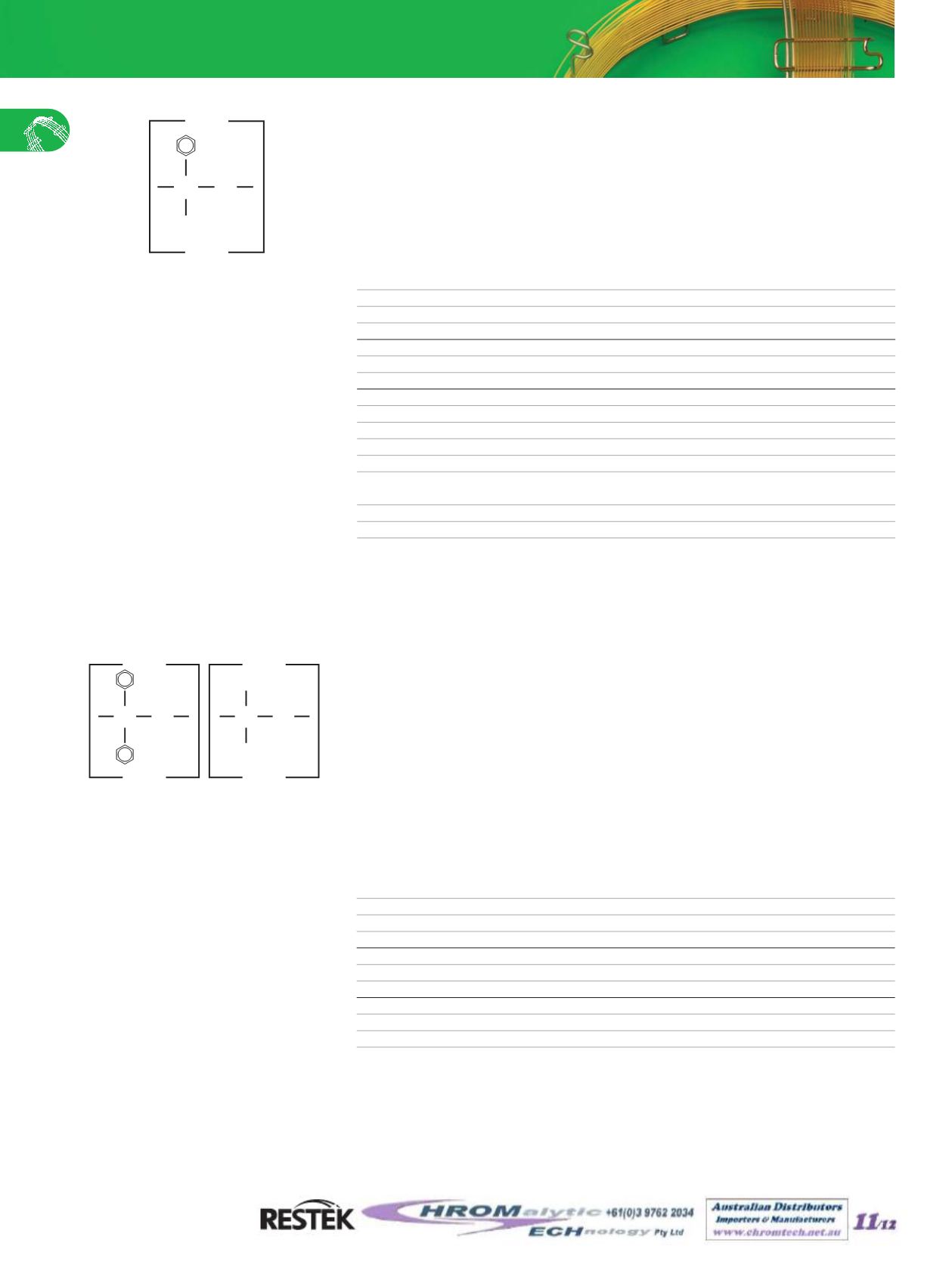
52
GCCOLUMNS |
GENERALPURPOSECOLUMNS
Rtx®-50, Rtx®-65
crossbond®
technology
reducesbleed, prolongs column lifetime, and
allows rejuvenation through solvent rinsing.
CH
3
CH
3
Si
35%
O
Si
65%
O
Rtx
®
-65Structure
also
available
MetalMXT®Columns
Rugged, flexible, Siltek® treated stainless steel
tubing; inertness comparable to fused silica
tubing. See
page117
forourMXT®-65
columns.
Rtx
®
-50Structure
CH
3
Si
100%
O
also
available
MetalMXT®Columns
Rugged, flexible, Siltek® treated stainless steel
tubing; inertness comparable to fused silica
tubing. See
page117
forourMXT®-50
columns.
also
available
Rtx®-65TGColumns
Tested specifically for triglycerides.
See
page72.
similar
phases
HP-50, SPB-50, SP-2250
Rtx®-50Columns
(fusedsilica)
(midpolarityphase; Crossbond® 50%phenyl/50%methyl polysiloxane)
• General purpose columns for pesticides, herbicides, rosin acids, phthalate esters,
triglycerides, sterols.
• Temperature range: 40 °C to320 °C.
• Equivalent toUSPG3phase.
The high thermal stability of Rtx®-50 columns makes possible dual-column analysis
with commonphases such asRtx®-1MSorRtx®-5MS. Between analyses, high temper-
atures canbeused todrive less volatile contaminants off of the column.
similar
phases
TAP-CB, 400-65HT, 007-65HT
Rtx®-65Columns
(fusedsilica)
(mid tohighpolarityphase; Crossbond®65%diphenyl/35%dimethyl polysiloxane)
• General purpose columns for phenols, fatty acids.
• Temperature range: 50 °C to300 °C.
• Equivalent toUSPG17phase.
TheRtx®-65phase contains thehighest phenyl content of anybonded stationaryphase
available, to improve separationof aromatic compounds through increasedphase-ana-
lyte interaction.Aunique polaritymakes these columns ideal for a variety of analyses,
from phenols to FAMEs. As a confirmation column for EPAMethod 604 phenols, an
Rtx®-65 column produces a different elution order, compared to the primary Rtx®-5
column.Rtx®-65 columns eluteFAMEs according to equivalent chain length, similar to
bondedCarbowax® columns, but theRtx®-65phasedoes not suffer the thermal stabil-
ity limitations of other polar stationaryphases.
ID
df
temp. limits
15-Meter
30-Meter
0.25mm 0.25µm 40 to 300/320°C
10520
10523
0.50µm 40 to 290/310°C
10535
10538
1.00µm 40 to 280/300°C
10550
10553
0.32mm 0.25µm 40 to 300/320°C
10521
10524
0.50µm 40 to 290/310°C
10536
10539
1.00µm 40 to 280/300°C
10551
10554
0.53mm 0.25µm 40 to 280/300°C
10522
0.50µm 40 to 270/290°C
10537
10540
0.83µm 40 to 270/290°C
10569
1.00µm 40 to 260/280°C
10552
10555
1.50µm 40 to 250/270°C
10567
10570
ID
df
temp. limits
10-Meter
20-Meter
0.18mm 0.20µm 40 to 310/330°C
40501
40502
0.40µm 40 to 300/320°C
40510
40511
ID
df
temp. limits
30-Meter
0.25mm 0.25µm
50 to 300°C
17023
0.50µm 50 to 280/300°C
17038
1.00µm 50 to 260/280°C
17053
0.32mm 0.25µm
50 to 300°C
17024
0.50µm 50 to 280/300°C
17039
1.00µm 50 to 260/280°C
17054
0.53mm 0.25µm 50 to 290/300°C
17025
0.50µm 50 to 270/290°C
17040
1.00µm 50 to 250/270°C
17055
Website :
E-mail :
TelNo : 03 9762 2034 . . . inAUSTRALIA
Mar 2011


